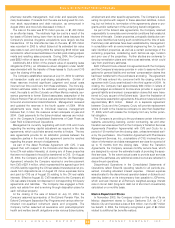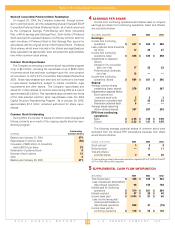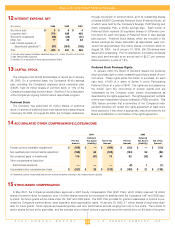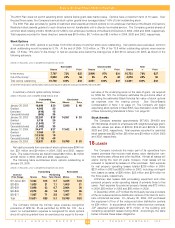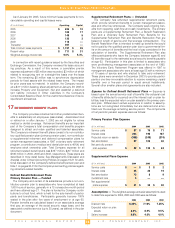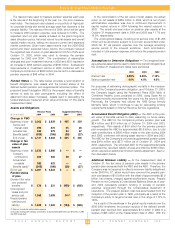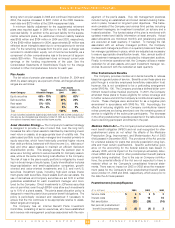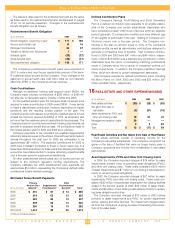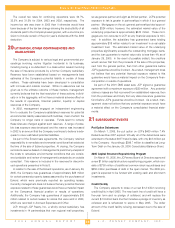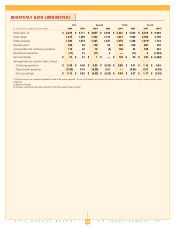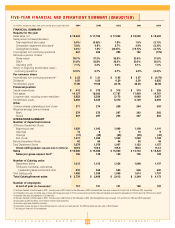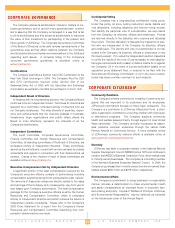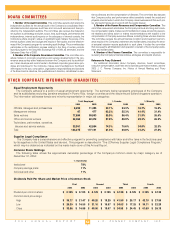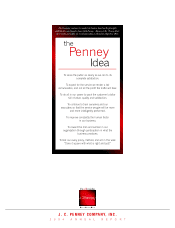JCPenney 2004 Annual Report Download - page 46
Download and view the complete annual report
Please find page 46 of the 2004 JCPenney annual report below. You can navigate through the pages in the report by either clicking on the pages listed below, or by using the keyword search tool below to find specific information within the annual report.
J.C. PENNEY COMPANY, INC.2 004 ANNUAL REPORT
Notes to the Consolidated Financial Statements
44
The discount rates used for the postretirement plan are the same
as those used for the defined benefit plans, as disclosed on pages
41-42, for all periods presented. Changes in the postretirement
benefit obligation are as follows:
Postretirement Benefit Obligation
($ in millions)
2004 2003
Benefit obligation, beginning of year
$ 171 $ 186
Service and interest cost
14 16
Participant contributions
33 37
Transfer of liability from Eckerd plan
1––
Actuarial (gain)
(28) (27)
Gross benefits paid
(42) (41)
Net postretirement obligation
$ 149 $ 171
The Company’s postretirement benefit plans were amended in
2001 to reduce and cap the per capita dollar amount of the bene-
fit costs that would be paid by the Company. Thus, changes in the
assumed or actual health care cost trend rates do not materially
affect the APBO or the Company’s annual expense.
Cash Contributions
Although no additional funding was required under ERISA, the
Company made voluntary contributions of $300 million, or $190 mil-
lion after tax, to its pension plan in October of 2004 and 2003.
For the qualified pension plan, the Company does not expect to be
required to make a contribution in 2005 under ERISA. It may decide
to make a discretionary contribution, however, depending on market
conditions and the resulting funded position of the plan. The
Company’s policy with respect to funding the qualified plan is to fund
at least the minimum required by ERISA of 1974, as amended, and
not more than the maximum amount deductible for tax purposes. The
Company does not currently have minimum funding requirements, as
set forth in employee benefit and tax laws. All contributions made to
the funded pension plan for 2004 and 2003 were voluntary.
Company payments to the unfunded non-qualified supplemental
retirement plans are equal to the amount of benefit payments made to
retirees throughout the year and for 2005 are anticipated to be
approximately $61 million. The expected contributions for 2005 to
2008 have increased compared to those in recent years due to a
December 2003 amendment to these plans that allowed participants
aone-time irrevocable election to receive remaining unpaid benefits
over a five-year period in equal annual installments.
All other postretirement benefit plans are not funded and are not
subject to any minimum regulatory funding requirements. The
Company estimates the 2005 postretirement plan payments will
approximate $14 million, representing the Company’s defined dollar
contributions toward medical coverage.
Estimated Future Benefit Payments
Primary Other
Pension Plan Supplemental Postretirement
($ in millions)
Benefits(1) Plan Benefits(1) Benefits(1) Total(1)
2005
$ 210 $ 61 $ 14 $ 285
2006
219 63 13 295
2007
229 65 13 307
2008
239 68 13 320
2009
250 19 13 282
2010-2014
1,412 99 63 1,574
(1) Does not include plan expenses.
Defined Contribution Plans
The Company’s Savings, Profit-Sharing and Stock Ownership
Plan is a defined contribution plan available to all eligible associ-
ates of the Company and certain subsidiaries. Associates who
have completed at least 1,000 hours of service within an eligibility
period (generally 12 consecutive months) and have attained age
21 are eligible to participate in the plan. Vesting of Company con-
tributions occurs over a five-year period. The Company con-
tributes to the plan an amount equal to 4.5% of the Company’s
available profits, as well as discretionary contributions designed to
generate a competitive level of benefits. Total Company contribu-
tions for 2004 and 2003 were $47 million and $45 million, respec-
tively, of which $19 million was a discretionary contribution in 2003.
Associates have the option of reinvesting matching contributions
made in Company stock into a variety of investment options, pri-
marily mutual funds. In addition, the Company has Mirror Savings
Plans, which are offered to certain management associates.
Total Company expense for defined contribution plans, including
the Mirror Plans, for 2004, 2003 and 2002 was $52 million, $47
million and $49 million, respectively.
18 REAL ESTATE AND OTHER EXPENSE/(INCOME)
($ in millions)
2004 2003 2002
Real estate activities
$ (30) $ (28) $ (25)
Net gains from sale of
real estate
(8) (51) (16)
Asset impairments, PVOL and
other unit closing costs
19 57 75
Management transition costs
29 –– ––
Other
2 5 25
Total
$ 12 $ (17) $59
Real Estate Activities and Net Gains from Sale of Real Estate
Real estate activities consist of operating income for the
Company’s real estate subsidiaries. The Company recognized net
gains on the sale of facilities that were no longer being used in
Company operations and income from investments in real estate
partnerships.
Asset Impairments, PVOL and Other Unit Closing Costs
In 2004, the Company recorded charges of $19 million for asset
impairments, present value of operating lease obligations (PVOL)
and other unit closing costs. These costs consisted of $12 million
of asset impairments and $7 million of unit closing costs related pri-
marily to remaining lease obligations.
In 2003, the Company recorded charges of $57 million for asset
impairments, PVOL and other unit closing costs. These costs con-
sisted of $22 million of accelerated depreciation for Catalog facilities
closed in the second quarter of 2003, $26 million of asset impair-
ments and $9 million of unit closing costs related primarily to remain-
ing lease obligations and other.
The Company recorded charges of $75 million in 2002 related
primarily to asset impairments and PVOL for certain department
stores, catalog and other facilities. The impairment charges result-
ed from the Company’s ongoing process of evaluating the produc-
tivity of its asset base.


